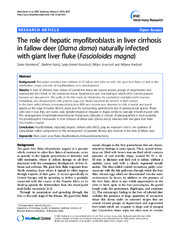Приказ основних података о документу
The role of hepatic myofibroblasts in liver cirrhosis in fallow deer (Dama dama) naturally infected with giant liver fluke (Fascioloides magna)
| dc.creator | Marinković, Darko | |
| dc.creator | Kukolj, Vladimir | |
| dc.creator | Aleksić-Kovačević, Sanja | |
| dc.creator | Jovanović, Milijan | |
| dc.creator | Knežević, Milijana | |
| dc.date.accessioned | 2020-06-03T13:42:28Z | |
| dc.date.available | 2020-06-03T13:42:28Z | |
| dc.date.issued | 2013 | |
| dc.identifier.issn | 1746-6148 | |
| dc.identifier.uri | https://vet-erinar.vet.bg.ac.rs/handle/123456789/1013 | |
| dc.description.abstract | Background: This paper describes liver cirrhosis in 35 fallow deer infected with the giant liver fluke, as well as the distribution, origin, and role of myofibroblasts in its development. Results: In liver of infected deer, stripes of connective tissue are wound around groups of degenerated and regenerated liver lobuli. In the connective tissue, lymphocytes and macrophages which often contain parasite hematin are also present. The walls of the bile ducts are thickened, the epithelium multiplied with mucous metaplasia, and desquamated cells, parasite eggs and brown pigment are present in their lumen. In the livers with cirrhosis, immunopositivity to alpha-SMA and desmin was observed in cells in portal and septal spaces, at the edge between fibrotic septa and the surrounding parenchyma and in perisinusoidal spaces. These cells vary in size, they are round, oval, spindle-shaped or irregular in shape, similar to vascular smooth muscle cells. The derangement of epithelial-mesenchymal interactions detected in chronic cholangiopathies is most probably the pro-fibrogenic mechanism in liver cirrhosis of fallow deer (Dama dama) infected with the giant liver fluke (Fascioloides magna). Conclusion: Myofibroblasts, especially hepatic stellate cells (HSCs), play an important role in the synthesis of extracellular matrix components in the development of parasitic fibrosis and cirrhosis in the liver of fallow deer. | en |
| dc.publisher | BMC, London | |
| dc.relation | info:eu-repo/grantAgreement/MESTD/Integrated and Interdisciplinary Research (IIR or III)/46002/RS// | |
| dc.rights | openAccess | |
| dc.source | BMC Veterinary Research | |
| dc.subject | Deer | en |
| dc.subject | Liver | en |
| dc.subject | Liver fluke | en |
| dc.subject | Myofibroblasts | en |
| dc.subject | Immunohistochemistry | en |
| dc.title | The role of hepatic myofibroblasts in liver cirrhosis in fallow deer (Dama dama) naturally infected with giant liver fluke (Fascioloides magna) | en |
| dc.type | article | |
| dc.rights.license | ARR | |
| dcterms.abstract | Кукољ, Владимир; Кнежевић, Милијана; Маринковић, Дарко; Јовановић, Милијан; Aлексић-Ковачевић, Сања; | |
| dc.citation.volume | 9 | |
| dc.citation.spage | 45 | |
| dc.citation.other | 9: 45 | |
| dc.citation.rank | aM21 | |
| dc.identifier.wos | 000316729800001 | |
| dc.identifier.doi | 10.1186/1746-6148-9-45 | |
| dc.identifier.pmid | 23497565 | |
| dc.identifier.scopus | 2-s2.0-84874522728 | |
| dc.identifier.fulltext | https://vet-erinar.vet.bg.ac.rs/bitstream/id/12/1012.pdf | |
| dc.type.version | publishedVersion |

